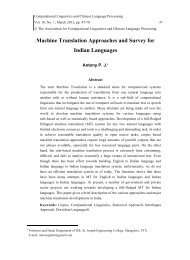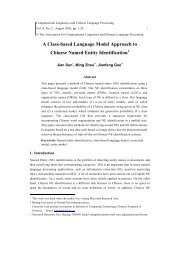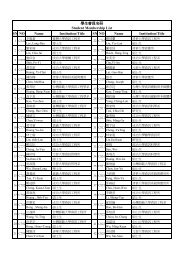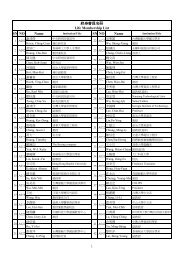Automatic Recognition of Cantonese-English Code ... - Aclclp.org.tw
Automatic Recognition of Cantonese-English Code ... - Aclclp.org.tw
Automatic Recognition of Cantonese-English Code ... - Aclclp.org.tw
Create successful ePaper yourself
Turn your PDF publications into a flip-book with our unique Google optimized e-Paper software.
294 Joyce Y. C. Chan et al.<br />
For <strong>Cantonese</strong> speech in the code-mixing utterances (CM), the recognition accuracies<br />
attained by ML_A and ML_B are 60.9% and 45.9% respectively. The poor performance <strong>of</strong><br />
ML_B is related to the use <strong>of</strong> language-dependent models as discussed above. The<br />
performance difference be<strong>tw</strong>een ML_A and ML_B for monolingual <strong>Cantonese</strong> utterances<br />
(MC) is not as significant as for the CM utterances. This is because the grammar ne<strong>tw</strong>ork used<br />
for MC utterances does not include an <strong>English</strong> segment, and therefore there should be no<br />
recognition error caused by the confusion be<strong>tw</strong>een similar <strong>Cantonese</strong> and <strong>English</strong> phonemes.<br />
CL uses a large number <strong>of</strong> shared phoneme models be<strong>tw</strong>een <strong>English</strong> and <strong>Cantonese</strong>. It<br />
attains the best recognition accuracy <strong>of</strong> 59% for the embedded <strong>English</strong> words, and at the same<br />
time, it maintains a reasonable performance on <strong>Cantonese</strong>. It is believed that the existing<br />
design <strong>of</strong> cross-lingual models can be improved further with more understanding about the<br />
phonetic variation in code-mixing speech. More training data will also be helpful.<br />
5. Language Modeling<br />
5.1 Collection and Selection <strong>of</strong> Text Data<br />
There are practical difficulties in collecting a large amount <strong>of</strong> text material to facilitate<br />
statistical language modeling for <strong>Cantonese</strong>-<strong>English</strong> code-mixing speech. <strong>Cantonese</strong> is a<br />
spoken dialect; many colloquial <strong>Cantonese</strong> words do not have a standard written form. In<br />
addition, written <strong>Cantonese</strong> is neither taught in schools nor recommended for <strong>of</strong>ficial and<br />
documentary usage. Nevertheless, a limited amount <strong>of</strong> <strong>Cantonese</strong> text data can be found in<br />
certain columns <strong>of</strong> local newspapers, magazines, advertisements, and online articles (Snow,<br />
2004). On the other hand, code-mixing is a domain-specific phenomenon. It is found in the<br />
discourses that involve contemporary and cross-cultural issues, e.g., computer, business,<br />
fashion, food, and showbiz (Li, 1996). In our study, <strong>Cantonese</strong> text data are selected from<br />
three major sources, namely newspaper, magazines, and online diaries. Preliminary manual<br />
inspection was done to identify the sections or columns that are highly likely to contain<br />
code-mixing text. A total <strong>of</strong> 28 Chinese characters that are frequently used in spoken<br />
<strong>Cantonese</strong> but rarely used in standard Chinese were identified, e.g., 嘅 , 嘢 , 咁 (Snow, 2004).<br />
Articles that contain these characters were considered to be written in <strong>Cantonese</strong>. As a result,<br />
a text database with 6.8 million characters was compiled. There are about 4600 distinct<br />
Chinese characters and 4200 distinct <strong>English</strong> segments in the database. About 10% <strong>of</strong> these<br />
<strong>English</strong> segments are included in the CUMIX utterances.<br />
5.2 Training <strong>of</strong> Language Models<br />
The text data were used to train character tri-grams. Four different models were trained:<br />
CAN_LM: mono-lingual <strong>Cantonese</strong> language model;









